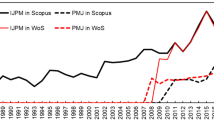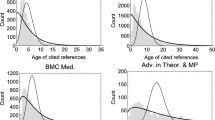Abstract
The Field Weighted Citation Index (FWCI) is an article age- and field-normalized metric to evaluate scientific visibility and impact. The Topic Prominence Percentile (TPP) is another parameter that allegedly measures an article’s “momentum.” Both are available at SciVal and are thought-provoking but have been scarcely used by the community, partially because it is very time-consuming to collect these parameters, paper by paper. In this article, we created and tested a computer code that can efficiently harvest the FWCI and TPP of articles of any chosen researcher, research group, or institution from the Scopus database. After collecting the desired data, our algorithm computes the sum, mean and standard deviation, mode, and median. It also calculates an alternative metric, proposed here, i.e., a normalized parameter that divides each FWCI by the number of authors of that article and then produces similar metrics. We first used the new algorithm to collect an article dataset from a selected researcher, used as an example, who has published 226 articles since 2000. The automated data collection task took 35 min versus 4 h manually. To demonstrate the power of this approach, we present the most relevant results. For instance, 20% of this researcher’s papers have achieved very high visibility, an FWCI ≥ 2. Surprisingly, however, his articles of the highest FWCI are not the most cited. His 20 oldest papers have a similar FWCI to the 20 newest, showing that his scientific output reached a steady-state long ago. Moreover, we discovered that the papers of the highest FWCI have a higher share (65%) of international collaborators than the articles of the lowest FWCI (< 40%). These results corroborate the well-known trend that international collaboration increases scientific visibility. To generalize these findings, we also successfully compared the FWCI statistics of several senior researchers and young investigators who work in diverse fields, revealing significant differences. This way, we demonstrated that the proposed computer code and resulting metrics provide a new scientometric tool. However, a drawback is that a significant fraction of the “topics” defined by SciVal does not perfectly fit the article’s field, which leads to errors in the computation of the FWCI. Therefore, while the FWCI is a handy parameter to evaluate and compare the scientific visibility and impact of researchers of any age and science field, reliable analyses will only be possible using an improved choice of topics.

Adapted from Montazerian et al. (2020), for N = 500 papers. (Color figure online)











Similar content being viewed by others
Data Availability
The generated codes are available at https://github.com/VinniciusC/FWCI-Scopus-project.
References
Alonso, S., Cabrerizo, F. J., Herrera-Viedma, E., & Herrera, F. (2009). H-index: A review focused in its variants, computation and standardization for different scientific fields. Journal of Informetrics, 3(4), 273–289.
Chang, L. L.-H., Phoa, F. K. H., & Nakano, J. (2019). A new metric for the analysis of the scientific article citation network. IEEE Access, 7, 132027–132032.
Claro, J., & Costa, C. (2011). A made-to-measure indicator for cross-disciplinary bibliometric ranking of researcher’s performance. Scientometrics, 86(1), 113–123.
Eckert, H. (2020). Personal communication.
Egghe, L. (2010). The Hirsch index and related impact measures. Annual Review of Information Science and Technology, 44(1), 65–114.
Hirsch, J. E. (2005). An index to quantify an individual’s scientific research output. Proceedings of the National Academy of Sciences of the United States of America, 102(46), 16569–16572.
Hu, G., Wang, L., Ni, R., & Liu, W. (2020). Which h-index? An exploration within the Web of Science. Scientometrics, 123(3), 1225–1233.
Huggett, S., James, C., & Palmaro, E. (2018). Field-weighting readership: How does it compare to field-weighting citations? Communications in Computer and Information Science, 856, 96–104.
Iglesias, J. E., & Pecharromán, C. (2007). Scaling the H-index for different scientific ISI fields. Scientometrics, 73(3), 303–320.
Ioannidis, J. P. A., Boyack, K., & Wouters, P. F. (2016). Citation metrics: A primer on how (not) to normalize. PLoS Biology, 14(9), e1002542.
Ioannidis, J. P. A., Klavans, R., & Boyack, K. W. (2018). Thousands of scientists publish a paper every five days. Nature, 561(7722), 167–169.
Kaptay, G. (2020). The k-index is introduced to replace the h-index to evaluate better the scientific excellence of individuals. Heliyon, 6(7), e04415.
Khor, K. A., & Yu, L.-G. (2016). Influence of international co-authorship on the research citation impact of young universities. Scientometrics, 107(3), 1095–1110.
Klavans, R., & Boyack, K. W. (2017). Research portfolio analysis and topic prominence. Journal of Informetrics, 11(4), 1158–1174.
Kochetkov, D. M. (2018). A correlation analysis of normalized indicators of citation. Publications, 6(3), 1. https://doi.org/10.3390/publications6030039.
Kreinovich, V., Kosheleva, O., & Nguyen, H. P. (2021). Why h-index. Studies in computational. Intelligence, 899, 61–65.
Liang, L. (2006). H-index sequence and h-index matrix: Constructions and applications. Scientometrics, 69(1), 153–159.
Montazerian, M., Zanotto, E. D., & Eckert, H. (2017). Bibliometrics in glass and other sciences: A Plea for reason. International Journal of Applied Glass Science, 8(3), 352–359.
Montazerian, M., Zanotto, E. D., & Eckert, H. (2019). A new parameter for (normalized) evaluation of H-index: Countries as a case study. Scientometrics, 118(3), 1065–1078.
Montazerian, M., Zanotto, E. D., & Eckert, H. (2020). Prolificacy and visibility versus reputation in the hard sciences. Scientometrics, 123, 207–221.
Namazi, M. R., & Fallahzadeh, M. K. (2010). N-index: A novel and easily-calculable parameter for comparison of researchers working in different scientific fields. Indian Journal of Dermatology, Venereology, and Leprology, 76(3), 229–230.
Norris, M., & Oppenheim, C. (2010). The H-index: A broad review of a new bibliometric indicator. Journal of Documentation, 66(5), 681–705.
Panaretos, J., & Malesios, C. (2009). Assessing scientific research performance and impact with single indices. Scientometrics, 81(3), 635–670.
Purkayastha, A., Palmaro, E., Falk-Krzesinski, H. J., & Baas, J. (2019). Comparison of two article-level, field-independent citation metrics: Field-weighted citation impact (FWCI) and relative citation ratio (RCR). Journal of Informetrics, 13(2), 635–642.
Radicchi, F., Fortunato, S., & Castellano, C. (2008). Universality of citation distributions: Toward an objective measure of scientific impact. Proceedings of the National Academy of Sciences of the United States of America, 105(45), 17268–17272.
Schubert, A., & Glänzel, W. (2007). A systematic analysis of Hirsch-type indices for journals. Journal of Informetrics, 1(2), 179–184.
Sidiropoulos, A., Katsaros, D., & Manolopoulos, Y. (2007). Generalized Hirsch H-index for disclosing latent facts in citation networks. Scientometrics, 72, 253–280.
Waltman, L. (2016). A review of the literature on citation impact indicators. Journal of Informetrics, 10(2), 365–391.
Wildgaard, L., Schneider, J. W., & Larsen, B. (2014). A review of the characteristics of 108 author-level bibliometric indicators. Scientometrics, 101(1), 125–158.
Zanotto, E. D. (2006). The scientists pyramid. Scientometrics, 69(1), 175–181.
Acknowledgements
We are grateful to CNPq, Brazil, and the São Paulo Research Foundation, Fapesp CEPID Grant # 2013/007793-6, for funding this research.
Author information
Authors and Affiliations
Corresponding author
Supplementary information
Below is the link to the electronic supplementary material.
Appendix
Appendix
The generated codes are available at https://github.com/VinniciusC/FWCI-Scopus-project.
What is SciVal’s Topic Prominence?
According to SciVal, a topic is a collection of documents with a common intellectual interest, which can be of any size, new or old, growing or declining in momentum. Topics are dynamic, they will evolve over time, and new topics will surface. As with the nature of today’s research landscape, many topics are multidisciplinary and old topics may be dormant, but they still exist. In addition, researchers work in various research areas and thereby contribute to multiple topics.
Topic
Topics are based on clustering the citation network of 95% of Scopus content (all documents published from 1996). Each Topic is a collection of documents with a common interest. For example: “Glass ceramics/crystallization/lithium disilicate”.
Topics are clustered within SciVal based upon direct citation analysis using document reference lists (a document can belong to only one Topic). As newly published documents are indexed, they are added to Topics using their reference lists. This makes Topics dynamic and most will increase in size over time.
Prominence
Calculating a Topic’s Prominence combines three metrics which indicate the momentum of the Topic.
-
Citation Count in year n to papers published in n and n − 1
-
Scopus View Count in year n for papers published in n and n − 1
-
Average Journa CiteScore for year n
Topics are then ranked by Prominence of these citation patterns, which indicates a Topic’s momentum in a field of study.
For more information, see Topic Prominence at Elsevier.com.
Rights and permissions
About this article
Cite this article
Zanotto, E.D., Carvalho, V. Article age- and field-normalized tools to evaluate scientific impact and momentum. Scientometrics 126, 2865–2883 (2021). https://doi.org/10.1007/s11192-021-03877-3
Received:
Accepted:
Published:
Issue Date:
DOI: https://doi.org/10.1007/s11192-021-03877-3




